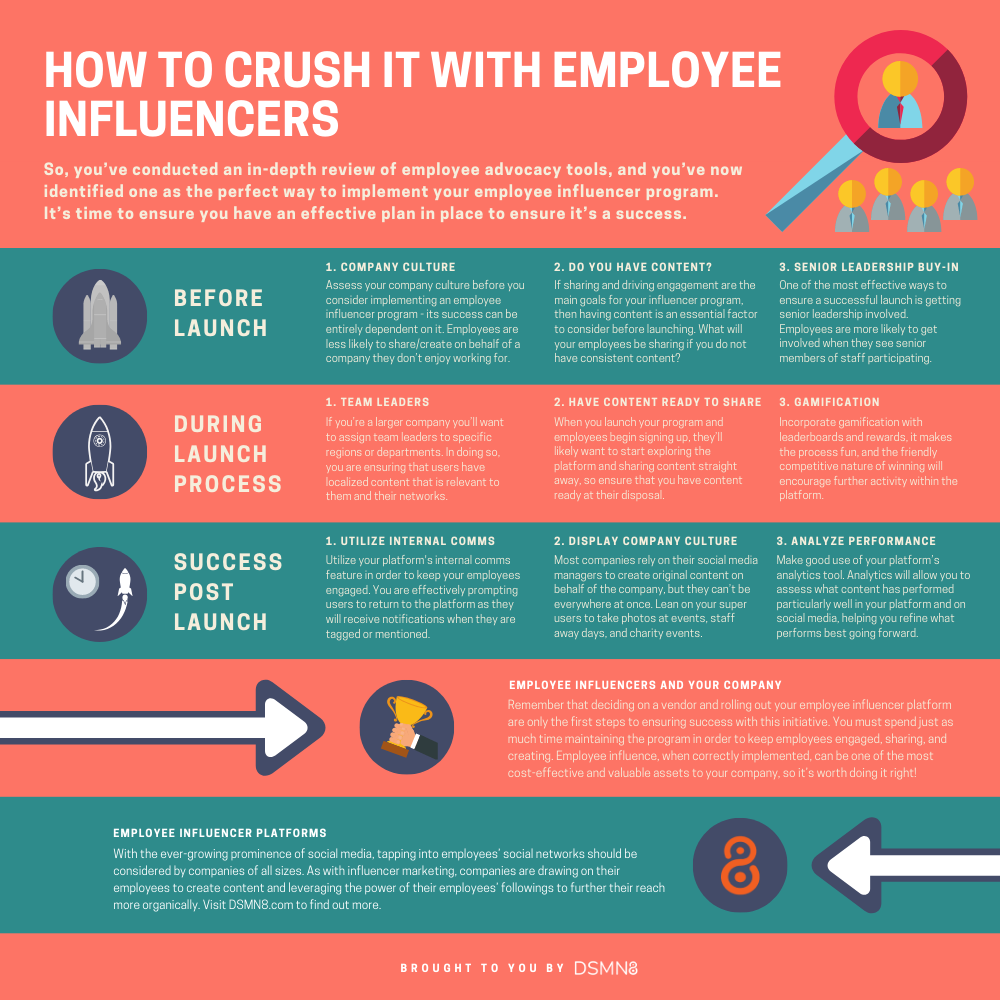
So, you’ve conducted an in-depth review of employee advocacy tools, and you’ve now identified one as the perfect way to implement your employee influencer program. It’s now time to ensure you have an effective plan in place to ensure it’s a success.
Without proper guidance, this can be a tricky process. However, a great vendor will guide you through the process from inception to post-launch, and typically you will have a dedicated customer success manager to help you through this.
Whether you have a customer success manager or not, following this guide will ensure your program is driving maximum sharing and engagement. Get it right, and your employees will be motivated, creating content, and will remain active long after the initial launch process.
This post is an excerpt from The Ultimate Guide to Employee Influencers by DSMN8.
The Guide intends to serve as the definitive companion for anyone looking to explore the power of employee influence for their organization, covering everything from trends driving the demand for employee influencers, to an all-encompassing business case. It also includes industry leader insights, infographics, and checklists for success. Download your copy today (it’s free!).

Before Launch
To determine if an employee influencer program is going to be right for your organization, these points should be checked and ticked before you consider implementation. Its success can be dependent on just a few contributing factors.
Company Culture
Ultimately, the essential factor in getting your employees to create and share on behalf of your brand is good company culture. Company culture is very much the personality of your brand and defines the environment in which your employees work.
Company culture does not have a definitive score, and can be tricky to measure. However, a helpful tip would be to check how your company scores on Glassdoor. Take a look at one or two reviews, and your CEO’s approval rating, to get an idea of how past/present employees feel about the company.
In many ways, you should consider your company culture before you even consider implementing an advocacy/influencer program, as its success can be entirely dependent on it. After all, employees will be much less likely to share/create on behalf of a company they don’t enjoy working for.
Good company culture is not something that can be achieved overnight. You must consider and get a feel for this before launching your advocacy program or trying to find influencers within your ranks.
Do You Have Content?
If sharing your company content and driving engagement is the main goal for your influencer program, then having engaging content is an essential factor to consider before you think about launching. After all, what will your employees be sharing if you do not have consistent content?
Company content comes in various forms. It could be a blog, a press release, or an event, among other things. It’s vital that content is readily available and that you have new content being created regularly.
Perhaps you’re starting an influencer program in order to increase your company content in a more cost-effective, organic way. In such cases, employee influencers will truly prosper with an employee advocacy platform like DSMN8, which allow your employees to create authentic content and share it on behalf of your company.
Senior Leadership Buy-In
One of the most effective ways to ensure a successful launch process is getting senior leadership buy-in from the start. Naturally, employees are more likely to get involved when they see influential/senior members of staff actively participating.
Senior leadership staff, such as C-Suite, are just as much a part of a company’s brand as they are employees, and they will have a significant influence on the rest of your staff.
Platform Identity
Have you considered what you are going to name your platform? A platform name will be an important buzzword that you can put into your communications before launch. Try to think of something that incorporates your brand, while making it clear what the platform hopes to achieve. You’ll want to ensure that it’s perceived as a company-wide initiative and not just another piece of software.
Brands like Adobe have perfectly executed this with their ‘Social Shift’ program, asking that employees take part in order to become ‘Adobe Brand Champions.’ The program name identifies a goal, while the ‘Brand Champions’ aspect empowers employees to want to become brand ambassadors.
Who Will You Ask to Join?
If you’re planning to start a trial before you officially launch, it will be worth considering who you are going to invite to participate.
Finding socially active employees can seem like an impossible task, especially if you’re an enterprise brand with thousands of employees. Fear not, as social media can be an invaluable asset to identify them. Try searching your company name on sites like LinkedIn and Twitter to find out which employees are already sharing off their own back. If you’re a brand that frequently uses hashtags, use these to your advantage when searching for active employees.
For the reasons mentioned above, we believe that getting senior leadership involved can be the most effective way to hit the ground running with company-wide adoption.
If you want to get a genuine feel for how your platform will perform when you implement it across the company, you may want to consider using traditional sampling methods to get a purer group of say, one to two hundred employees.
Strong Opening Communications Before Launch
Opening communications will prove to be an effective way of getting employees both excited and curious about the initiative before you begin a company-wide rollout. It may be a few emails a couple of weeks before launch, or some mentions of the program via internal comms tools.
This would be another chance to leverage the influence of senior leadership by asking them to send out emails or announcements via internal comms tools or via email. However you choose to do this, it will prove to be a great way to boost familiarity and maximize adoption once launched.
How are you going to launch?
Your launch method will tie in with your communications before launch, but deciding how you are going to launch your influencer program can positively affect adoption rates and enthusiasm from users.
Consider here how the company has launched and announced previous initiatives. Which ones were the most successful/well-received, and why? Companies often opt for webinars and “Lunch and Learn” days in such instances, but fail to secure attendance as they’re usually optional and thus go unnoticed.
Companies have seen phenomenal results by organizing events to tie in with the launch of their program, as it’s proved to be a great way to generate buzz around a new company initiative and increase familiarity with the name and idea.

During Launch
So, you’ve followed each of these steps, ticked each one-off, and you’re now ready to launch. In many ways, this can be the vital step in ensuring success with your influencer program, as it will set the precedent of how the initiative will be managed and give employees an idea of what to expect moving forward.
Team Leaders
If you’re a larger company that operates in various corners of the world, or if you have various/very different departments within your company, then you’ll want to consider assigning team leaders to specific regions or departments. In doing so, you are ensuring that users have localized content that is relevant to them and their networks, no matter their role, language, or geographical location.
You are also evenly dispersing the workload to ensure that the platform does not become a time-consuming burden of one admin user. After all, that one user may not specialize in all departments, and you don’t want the global admin managing users and content that they may be unfamiliar with.
Have Content Ready to Share
Having ready-to-share content is a somewhat obvious aspect of an influencer program if your goal is to get employees sharing, but it’s worth consideration and checking nonetheless.
When you launch your program and employees begin signing up, they’ll likely want to start exploring the platform and sharing content straight away, so ensure that you have content ready at their disposal. Influencer platforms like DSMN8 allow you to schedule content into the platform for future use, which will reduce the number of times admin users will need to spend on it each week.
Gamification
One of the best ways to ensure employees start creating and sharing is gamification. Incorporating leaderboards and rewards is an excellent way to do this, as it makes the process fun, and the friendly competitive nature of winning will encourage further activity within the platform.
Rewards can also be a fantastic way to bring in entice employees who might have been skeptical about joining the platform. They’ll likely hear about it from participating employees, as it generates something of a buzz within an office environment and raises awareness about the initiative.
Rewards could be anything from Amazon vouchers to charity donations. A brand that championed this is Chinese tech-titans Huawei, who launched an advocacy program with DSMN8 back in 2018. They offered up their latest smartphones as rewards for top-performing employees, along with shopping vouchers and exercise-tracking accessories. Read the Huawei Case Study.
Incentivize employees to create original content for your brand by offering more points for doing so. If you incorporate leaderboards and offer ten points for sharing content, consider offering double this, or more, to get employees creating original content on behalf of the company.

Success Post Launch
This is the most crucial part of maintaining a successful employee influencer platform, as without continued management, new incentives, and content creation opportunities, employees may begin to lose interest or fail to see the long-term value.
Daunting as this may sound, this is very easily avoided by merely having your admin users and team leaders spend as little as 1.5 hours a week managing your platform. Ensure you’re ticking all of the boxes on the following points, and your program will continue to prosper, even long after the launch process.
Fresh Content
Having ready-to-share content is the first step, ensuring that there is always content readily available to share is the long-term goal. Providing your content creators continue to produce content at the same rate; it is essential that your team leaders/admin users are spending a sufficient amount of time in the platform each week to ensure that content easily is accessible to employees.
The most effective way of having on-brand and original content is by leveraging the power of your most valuable assets – your employees/users. Continued incentives will ensure that your employees continue to create content for your company to share.
Senior Leadership Engagement
As previously mentioned, senior leadership and C-suite staff can have vast amounts of influence on your employees’ sharing and creation habits.
These senior users must continue to participate in your influencer program as they’ll want to lead by example. If employees notice a lack of presence from senior staff, they may start to believe that the initiative is losing traction.
It’s also worth noting that senior staff will typically have larger networks on social media, and they tend to be connected to other senior staff members at potential companies of interest, which is a massive incentive for B2B brands.
Use Internal Comms Tools to Maintain Engagement
If your chosen vendor offers an internal communications aspect to their platform, it would be a good idea to utilize this in order to keep your employees engaged.
DSMN8 offers various internal communications features, including likes, comments, internal posts, and polls. You are also able to tag users and give them a company-wide shout-out via the ‘high five’ feature. This is particularly effective when adopted by senior staff as it allows them to show appreciation to their employees, whether it be within the platform or on social media. In a way, it humanizes the idea of senior management and brings them closer to your employees.
By utilizing these tools, you are effectively prompting users to return to the platform as they will receive notifications when they are tagged or mentioned. Users will return to the platform through a fear of missing out and wanting to keep up to date.
Individual Case Studies
Have you noticed a particular employee is driving significant engagement on social media? Perhaps they’ve created blog content or snapped pictures at a recent event that has performed particularly well on your company page.
Well, let them and the rest of your users know by producing an individual case study that highlights the impact they’ve had on driving engagement. Your super users will be hugely beneficial and have a lot of influence on social media. They will also be the ideal employees to approach when you’re looking to source original content.
This is a great way to validate and show appreciation for one of your employees for their hard work, and it also shows other users the benefits of the employee influencer program in numbers or stats.
Share Industry News
Sharing industry news, as well as company content, can be an excellent way for your employees to establish themselves as thought leaders on social, which will enable them to maximize their social selling capabilities.
This will be especially beneficial for your users who work in sales, as 92% of B2B buyers are willing to engage with a sales professional who is a known industry thought leader and 31% of B2B salespeople say that social selling tools helped them build deeper relationships with clients.
Display Company Culture
Remember that as a company, it is just as important to showcase your company culture as it is to promote your brand if you want to attract top talent. For many top candidates, company culture is a crucial factor in the decision-making process. LinkedIn reports that Companies with strong employer brands cut their cost per hire by as much as half.
Utilize your employees and super users to create content. Most companies rely on their social media managers to create original content on behalf of the company, but they can’t be everywhere at once! Lean on your super users to take photos at events, staff away days, and charity events.
Analyze Content Performance
To ensure you are sharing only the most top-quality and engagement driving content, you should make use of your platform’s analytics tool.
Analytics will allow you to assess what content has performed particularly well in your platform and on social media, which will help you refine what works and what might not work going forward.

Remember that deciding on a vendor and rolling out your employee influencer platform are only the first steps to ensuring success with this initiative. You must spend just as much time maintaining the program in order to keep employees engaged, sharing, and creating.
Employee influence, when correctly implemented, can be one of the most cost-effective and valuable assets to your company, so it’s worth doing it right!
Employee Advocacy Success Checklist

Thinking of starting you own employee influencer program and not sure where to start? Get in touch and schedule a demo.
Lewis Gray
Senior Marketing Manager and Employee Advocacy Program Manager at DSMN8. Lewis specialises in content strategy, growing brand visibility and generating inbound leads. His background in Sales lends itself well to demand generation in the B2B niche.


